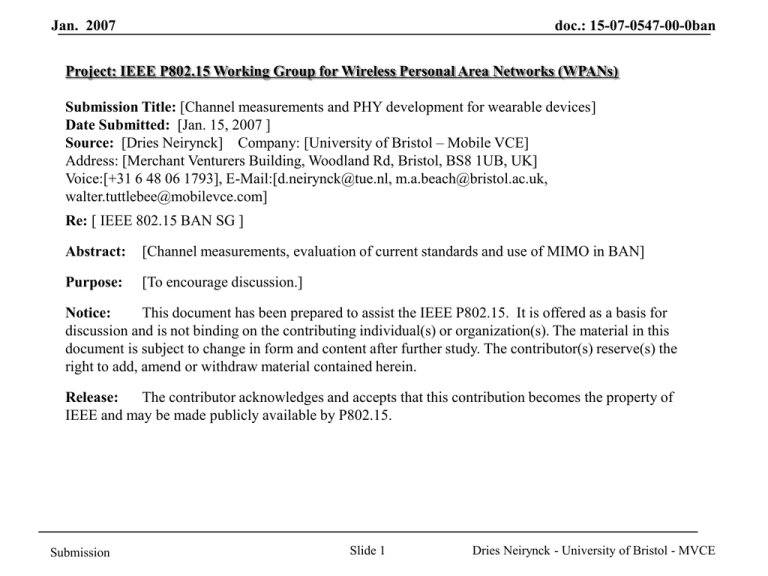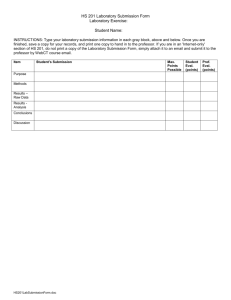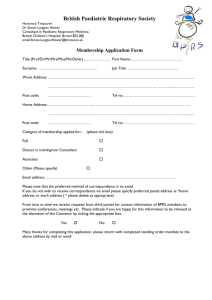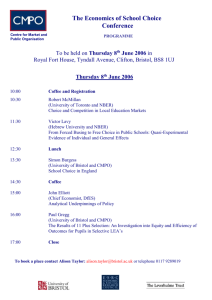Jan. 2007 doc.: 15-07-0547-00-0ban
advertisement

doc.: 15-07-0547-00-0ban Jan. 2007 Project: IEEE P802.15 Working Group for Wireless Personal Area Networks (WPANs) Submission Title: [Channel measurements and PHY development for wearable devices] Date Submitted: [Jan. 15, 2007 ] Source: [Dries Neirynck] Company: [University of Bristol – Mobile VCE] Address: [Merchant Venturers Building, Woodland Rd, Bristol, BS8 1UB, UK] Voice:[+31 6 48 06 1793], E-Mail:[d.neirynck@tue.nl, m.a.beach@bristol.ac.uk, walter.tuttlebee@mobilevce.com] Re: [ IEEE 802.15 BAN SG ] Abstract: [Channel measurements, evaluation of current standards and use of MIMO in BAN] Purpose: [To encourage discussion.] Notice: This document has been prepared to assist the IEEE P802.15. It is offered as a basis for discussion and is not binding on the contributing individual(s) or organization(s). The material in this document is subject to change in form and content after further study. The contributor(s) reserve(s) the right to add, amend or withdraw material contained herein. Release: The contributor acknowledges and accepts that this contribution becomes the property of IEEE and may be made publicly available by P802.15. Submission Slide 1 Dries Neirynck - University of Bristol - MVCE doc.: 15-07-0547-00-0ban Jan. 2007 Aim Contribute to the drafts of the PAR and 5C by presenting the results of channel measurement campaigns into personal and body area propagation and of 802.15.1 and 15.3 PHY simulations using the recorded channel data Performed at the University of Bristol as part of the Mobile VCE Core 3 Programme Fully detailed technical reports on this research are available to Industrial Members of Mobile VCE. Submission Slide 2 Dries Neirynck - University of Bristol - MVCE doc.: 15-07-0547-00-0ban Jan. 2007 Fully detailed technical reports on this research are available to Industrial Members of Mobile VCE: In cooperation with the UK’s leading comms research Universities Submission Slide 3 Dries Neirynck - University of Bristol - MVCE doc.: 15-07-0547-00-0ban Jan. 2007 BAN versus PAN In the context of this research defined as: BAN: two (or more) communicating devices are located on the user’s body PAN: only one of the communicating devices is carried by the user Submission Slide 4 Dries Neirynck - University of Bristol - MVCE doc.: 15-07-0547-00-0ban Jan. 2007 Overview Does the user have a significant influence on BAN channel characteristics? How do existing 802.15 standards perform in the measured channels? What’s the benefit of using multiple antennas in BAN? Submission Slide 5 Dries Neirynck - University of Bristol - MVCE doc.: 15-07-0547-00-0ban Jan. 2007 Does the user have a significant influence on BAN channel characteristics? No indication that user effects were taken into account during design of existing 802.15 standards: Bluetooth (IEEE 802.15.1): Channel assumptions based on WLAN Attenuation and fading simply based on distance TX-RX IEEE 802.15.3 Channel model adapted from 802.11 Exponentially decaying, Rayleigh fading tapped delay line Submission Slide 6 Dries Neirynck - University of Bristol - MVCE doc.: 15-07-0547-00-0ban Jan. 2007 2 BAN channel measurement campaigns have been carried out MIMO channel sounder (Medav Rusk BRI) Dual Polar Patch antennas 120 MHz @ 5.2 GHz Office and anechoic chamber Submission Slide 7 Vector network analyser UWB antennas to measure simultaneously in: 20 MHz @ 1.9 GHz 20 MHz @ 2.1 GHz 80 MHz @ 2.4 GHz 120 MHz @ 5.2 GHz Several indoor locations, outdoor and anechoic chamber Dries Neirynck - University of Bristol - MVCE doc.: 15-07-0547-00-0ban Jan. 2007 Submission Slide 8 Dries Neirynck - University of Bristol - MVCE doc.: 15-07-0547-00-0ban Jan. 2007 Submission Slide 9 Dries Neirynck - University of Bristol - MVCE doc.: 15-07-0547-00-0ban Jan. 2007 Submission Slide 10 Dries Neirynck - University of Bristol - MVCE doc.: 15-07-0547-00-0ban Jan. 2007 Submission Slide 11 Dries Neirynck - University of Bristol - MVCE doc.: 15-07-0547-00-0ban Jan. 2007 User has significant influence on channel characteristics Body shadowing leads to severe signal attenuation During periods of NLOS, link becomes dependent on multipath propagation in the environment User motion leads to huge variation in the channel During periods of motion, coherence time is reduced to tens of milliseconds Submission Slide 12 Dries Neirynck - University of Bristol - MVCE doc.: 15-07-0547-00-0ban Jan. 2007 Measured channel characteristics differ from assumptions during development 802.15.1/3 Bluetooth (IEEE 802.15.1) Channel assumptions based on WLAN measurements attenuation and fading statistics are simply related to distance between transmitter and receiver link budget: 62 dB attenuation at 10 metres (observed at much shorter distance in measurements) IEEE 802.15.3 Exponentially decaying, Rayleigh fading model from 802.11 RMS delay spread of 25 ns should be tolerated 99.9% reliability at 10 metres No indication that body shadowing is taken into account Submission Slide 13 Dries Neirynck - University of Bristol - MVCE doc.: 15-07-0547-00-0ban Jan. 2007 How do existing 802.15 standards perform in the measured channels? Submission Slide 14 Dries Neirynck - University of Bristol - MVCE doc.: 15-07-0547-00-0ban Jan. 2007 Bluetooth/IEEE 802.15.1 simulation Parameters: Baseband only, other layers ideal GFSK modulator (h = 0.28), FEC implemented Demodulation with phase differentiator Packet header info known to receiver Throughput approximated by Throughput = (1-PER) x max. rate 100 bytes packet length TX power 0 dBm Thermal noise + 20 dB RX noise figure Recorded narrowband channel attenuation 2.4 GHz band Submission Slide 15 Dries Neirynck - University of Bristol - MVCE doc.: 15-07-0547-00-0ban Jan. 2007 Bluetooth / IEEE 802.15.3 performs poorly Submission Slide 16 Dries Neirynck - University of Bristol - MVCE doc.: 15-07-0547-00-0ban Jan. 2007 IEEE 802.15.3 simulation Parameters: Baseband only, other layers assumed ideal Modulation and FEC implemented Receiver: noise-whitening matched filter + DFE(4,3), Viterbi decoder for TC-QAM, Perfect knowledge of channel and packet header info Throughput approximated as before 100 bytes packet length TX power 10 dBm Thermal noise + 12 dB RX noise figure Recorded narrowband channel attenuation 2.4 GHz band Submission Slide 17 Dries Neirynck - University of Bristol - MVCE doc.: 15-07-0547-00-0ban Jan. 2007 IEEE 802.15.3 model can perform well Submission Slide 18 Dries Neirynck - University of Bristol - MVCE doc.: 15-07-0547-00-0ban Jan. 2007 What’s the benefit of using multiple antennas in BAN? Submission Slide 19 Dries Neirynck - University of Bristol - MVCE doc.: 15-07-0547-00-0ban Jan. 2007 The measurement data from the MIMO channel sounder is used MIMO channel sounder (Medav Rusk BRI) Dual Polar Patch antennas 2 antennas per ‘terminal’ 120 MHz @ 5.2 GHz Office and anechoic chamber 30 second routine consisting of sitting, standing, turning body and touching toes Submission Slide 20 Dries Neirynck - University of Bristol - MVCE doc.: 15-07-0547-00-0ban Jan. 2007 Both the use of spatial and polarisation diversity result in considerable capacity increases Submission Slide 21 Dries Neirynck - University of Bristol - MVCE doc.: 15-07-0547-00-0ban Jan. 2007 2-by-2 Space-time coding is evaluated based on a scheme proposed by Lindskog 2-by-2 MIMO extension of 802.15.3 based on Lindskog’s adaptation of Alamouti’s scheme for wideband channels Parameters identical to 802.15.3 simulation Total TX power kept constant Except for measured MIMO channels (5.2 GHz!) 802.15.3 TX Lindskog Encoder Decoder MIMO DFE 802.15.3 RX Decoder Submission Slide 22 Dries Neirynck - University of Bristol - MVCE doc.: 15-07-0547-00-0ban Jan. 2007 Space-time coding can be used to increase reliability and/or lower TX power Submission Slide 23 Dries Neirynck - University of Bristol - MVCE doc.: 15-07-0547-00-0ban Jan. 2007 A 2-by-2 spatial multiplexing extension to 802.15.3 has been investigated Parameters identical to 802.15.3 simulation Total TX power kept constant (10 dBm) Except for measured MIMO channels (5.2 GHz) TX1 802.15.3 TX interleaver TX2 RX2 RX1 -1 deinterleaver MIMO DFE Submission Slide 24 802.15.3 RX Dries Neirynck - University of Bristol - MVCE doc.: 15-07-0547-00-0ban Jan. 2007 Performance in BAN channels Submission Slide 25 Dries Neirynck - University of Bristol - MVCE doc.: 15-07-0547-00-0ban Jan. 2007 How can the PHY exploit the presence of multiple antennas in PAN or BAN? Increase reliability of link with space-time coding 2-by-2 extension based on Lindskog’s scheme evaluated 4-5 dB SNR reduction for similar throughput in BAN channels can be used to extend range or lower TX power Increase throughput of link with spatial multiplexing 2-by-2 extension achieves predicted doubling of the throughput Submission Slide 26 Dries Neirynck - University of Bristol - MVCE doc.: 15-07-0547-00-0ban Jan. 2007 Final Overview Body shadowing severely attenuates the signal User motion leads to a very variable channel This affects the performance of current PAN standards particularly in the case of Bluetooth/802.15.1 Use of multiple antennas should be considered Submission Slide 27 Dries Neirynck - University of Bristol - MVCE doc.: 15-07-0547-00-0ban Jan. 2007 Thank you! What question do you have? d.neirynck@tue.nl m.a.beach@bristol.ac.uk walter.tuttlebee@mobilevce.com Submission Slide 28 Dries Neirynck - University of Bristol - MVCE






